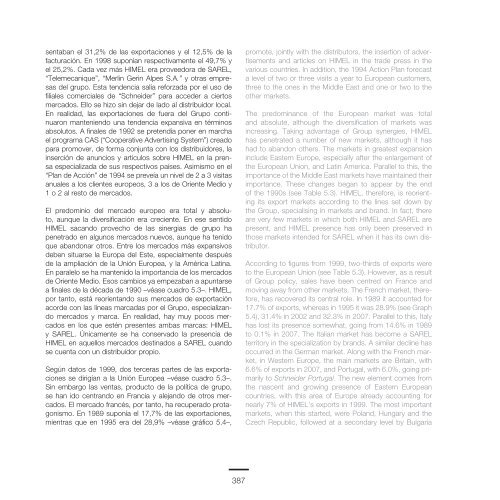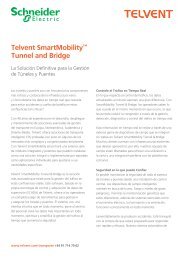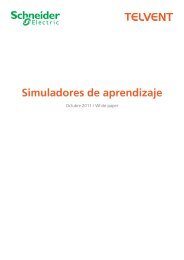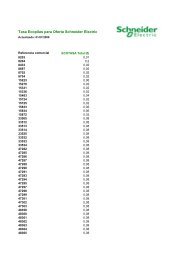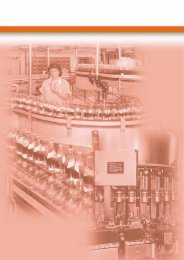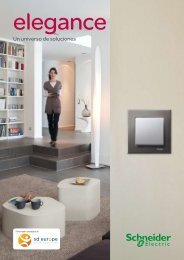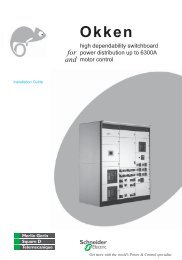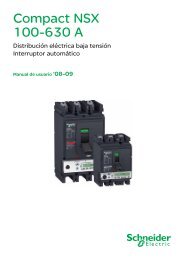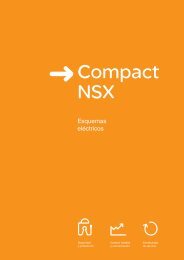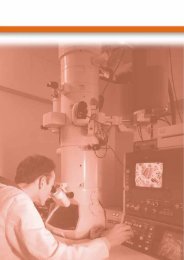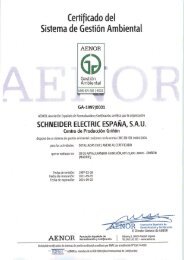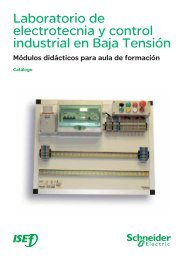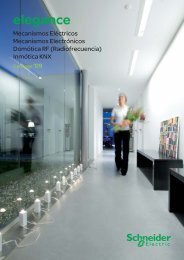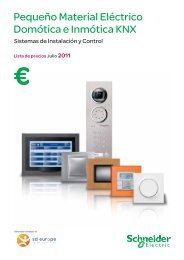Untitled - Schneider Electric
Untitled - Schneider Electric
Untitled - Schneider Electric
You also want an ePaper? Increase the reach of your titles
YUMPU automatically turns print PDFs into web optimized ePapers that Google loves.
sentaban el 31,2% de las exportaciones y el 12,5% de lafacturación. En 1998 suponían respectivamente el 49,7% yel 25,2%. Cada vez más HIMEL era proveedora de SAREL,“Telemecanique”, “Merlin Gerin Alpes S.A.” y otras empresasdel grupo. Esta tendencia salía reforzada por el uso defiliales comerciales de “<strong>Schneider</strong>” para acceder a ciertosmercados. Ello se hizo sin dejar de lado al distribuidor local.En realidad, las exportaciones de fuera del Grupo continuaronmanteniendo una tendencia expansiva en términosabsolutos. A finales de 1992 se pretendía poner en marchael programa CAS (“Cooperative Advertising System”) creadopara promover, de forma conjunta con los distribuidores, lainserción de anuncios y artículos sobre HIMEL en la prensaespecializada de sus respectivos países. Asimismo en el“Plan de Acción” de 1994 se preveía un nivel de 2 a 3 visitasanuales a los clientes europeos, 3 a los de Oriente Medio y1 o 2 al resto de mercados.El predominio del mercado europeo era total y absoluto,aunque la diversificación era creciente. En ese sentidoHIMEL sacando provecho de las sinergias de grupo hapenetrado en algunos mercados nuevos, aunque ha tenidoque abandonar otros. Entre los mercados más expansivosdeben situarse la Europa del Este, especialmente despuésde la ampliación de la Unión Europea, y la América Latina.En paralelo se ha mantenido la importancia de los mercadosde Oriente Medio. Esos cambios ya empezaban a apuntarsea finales de la década de 1990 –véase cuadro 5.3–. HIMEL,por tanto, está reorientando sus mercados de exportaciónacorde con las líneas marcadas por el Grupo, especializandomercados y marca. En realidad, hay muy pocos mercadosen los que estén presentes ambas marcas: HIMELy SAREL. Únicamente se ha conservado la presencia deHIMEL en aquellos mercados destinados a SAREL cuandose cuenta con un distribuidor propio.Según datos de 1999, dos terceras partes de las exportacionesse dirigían a la Unión Europea –véase cuadro 5.3–.Sin embargo las ventas, producto de la política de grupo,se han ido centrando en Francia y alejando de otros mercados.El mercado francés, por tanto, ha recuperado protagonismo.En 1989 suponía el 17,7% de las exportaciones,mientras que en 1995 era del 28,9% –véase gráfico 5.4–,promote, jointly with the distributors, the insertion of advertisementsand articles on HIMEL in the trade press in thevarious countries. In addition, the 1994 Action Plan forecasta level of two or three visits a year to European customers,three to the ones in the Middle East and one or two to theother markets.The predominance of the European market was totaland absolute, although the diversification of markets wasincreasing. Taking advantage of Group synergies, HIMELhas penetrated a number of new markets, although it hashad to abandon others. The markets in greatest expansioninclude Eastern Europe, especially after the enlargement ofthe European Union, and Latin America. Parallel to this, theimportance of the Middle East markets have maintained theirimportance. These changes began to appear by the endof the 1990s (see Table 5.3). HIMEL, therefore, is reorientingits export markets according to the lines set down bythe Group, specialising in markets and brand. In fact, thereare very few markets in which both HIMEL and SAREL arepresent, and HIMEL presence has only been preserved inthose markets intended for SAREL when it has its own distributor.According to figures from 1999, two-thirds of exports wereto the European Union (see Table 5.3). However, as a resultof Group policy, sales have been centred on France andmoving away from other markets. The French market, therefore,has recovered its central role. In 1989 it accounted for17.7% of exports, whereas in 1995 it was 28.9% (see Graph5.4), 31.4% in 2002 and 32.3% in 2007. Parallel to this, Italyhas lost its presence somewhat, going from 14.6% in 1989to 0.1% in 2007. The Italian market has become a SARELterritory in the specialization by brands. A similar decline hasoccurred in the German market. Along with the French market,in Western Europe, the main markets are Britain, with6.6% of exports in 2007, and Portugal, with 6.0%, going primarilyto <strong>Schneider</strong> Portugal. The new element comes fromthe nascent and growing presence of Eastern Europeancountries, with this area of Europe already accounting fornearly 7% of HIMEL’s exports in 1999. The most importantmarkets, when this started, were Poland, Hungary and theCzech Republic, followed at a secondary level by Bulgaria387


